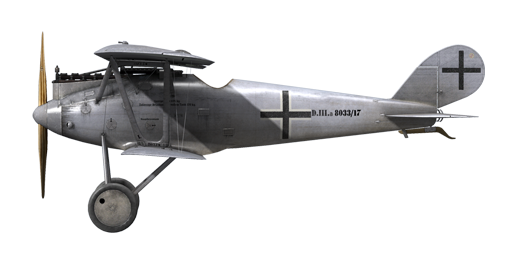il2
Pfalz D.IIIa

Description
The Pfalz D.III was designed by Pfalz Flugzeugwerke. German engineers were impressed by the famous French Nieuport fighters, which were designed with “one-and-a-half” wings. As such, Pfalz’s design was based on the achievements of French engineers. The first trial flight was carried out in May 1917. The plane’s design featured machine guns mounted on the sides of the engine and aileron control wires situated in the lower wing. Half a year later, the Pfalz D.IIIa was introduced. It featured a more powerful engine, a larger tail fin, a modified shape of the lower wing and machine guns mounted at the pilot’s line of sight. In all, 1010 Pfalz D.III and Pfalz D.IIIa aircraft were built.
In June 1917, the first Pfalz D.IIIs entered service with combat squadrons. The plane was used for bomber escort and for engaging enemy fighters and balloons. Pilots noted its exceptional cockpit visibility, good manoeuvrability, and stability when firing the machine guns; speed and climb rate were described as good. Some pilots claimed that its control sensitivity was even better than that of the Albatros D.V. Its structural durability permitted steep dives in combat and successful forced landings. English and French pilots claimed that one could shoot it down only when seriously wounding or killing the pilot. Its flight characteristics improved slightly when the Mercedes D.IIIa engine was fitted. The plane participated in battles over the Western and the Turkish fronts.
Engine
Inline 6 cyl. Mercedes D.IIIa, 180 hp
Dimensions
Height: 2670 mm
Length: 6950 mm
Wing span: 9400 mm
Wing surface: 22,09 sq.m
Weight
Empty: 725
Takeoff: 905
Fuel capacity: 94 l
Oil capacity: 20 l
Maximum airspeed (IAS)
sea level — 171 km/h
1000 m — 164 km/h
2000 m — 155 km/h
3000 m — 147 km/h
4000 m — 138 km/h
5000 m — 127 km/h
6000 m — 114 km/h
Climb rate
1000 m — 3 min. 23 sec.
2000 m — 7 min. 19 sec.
3000 m — 12 min. 02 sec.
4000 m — 18 min. 01 sec.
5000 m — 26 min. 22 sec.
6000 m — 40 min. 53 sec.
Service ceiling 6100 m
Endurance at 1000m
nominal power (combat) — 1 h. 30 min.
minimal consumption (cruise) — 2 h. 50 min.
Armament
Forward firing: 2хLMG 08/15 Spandau 7,92mm, 500 rounds per barrel.
References
1) Pfalz D.IIIa by PM Grosz. Windsock Datafile 21.
2) German Aircraft of World War I. Grey and Thetford ISBN 0851778097.
3) Pfalz scout Aces of World War I. Greg Van Wyngarden, Osprey № 71.
4) Flight magazine, Aprel 1918.
5) The Pfalz D.III , Profile Publications Number 43.
Modifications
Thermometer
A.Schlegelmilch engine coolant temperature indicator (0-100 °C)
Additional mass: 1 kg
High Altimeter
D.R.P Altimeter (0-8000 m)
Additional mass: 1 kg
Gunsight
Additional sight with front sight and rear sight mountings
Additional mass: 1 kg
Collimator Day
Oigee Reflector-type Collimator sight (daytime dimmer installed)
Additional mass: 2 kg
Inclinometer
D.R.G.M liquid Inclinometer (indicates bank while on ground and sideslip while in flight)
Additional mass: 1 kg
Bullet Counters
Wilhelm Morell needle scale Bullet Counters for 2 machine guns
Additional mass: 1 kg
Collimator Night
Oigee Reflector-type Collimator sight (daytime dimmer removed)
Additional mass: 2 kg
Anemometer
Wilhelm Morell Anemometer (45-250 km/h)
Additional mass: 1 kg
Cockpit light
Cockpit illumination lamp for night sorties
Additional mass: 1 kg